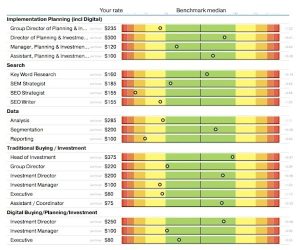With agency rates varying widely across different markets and industries, it can be challenging for agencies to determine what rates to charge their clients. TrinityP3’s agency rate benchmarking resources help marketing agencies better understand market rates for their services and set their fees accordingly.
The page covers a range of topics related to agency rate benchmarking, including how to evaluate market rates for specific marketing services, how to position pricing as a competitive advantage, and how to negotiate effectively with clients. By using these resources, marketing agencies can improve their pricing strategy and better understand their clients’ expectations around pricing.
You can find more information on agency growth advisory here or explore more details and insights below.

What does financial and rate benchmarking mean at TrinityP3?

Why average cost per agency FTE is dependent on the task at hand

Agencies talk about creativity. Consultants talk about insights.

Assess your agency’s performance with accurate agency benchmarks

The importance of rates in assessing an agency and their people

A simple way to check your advertising agency fees

How do your agency rates stack up and why?

